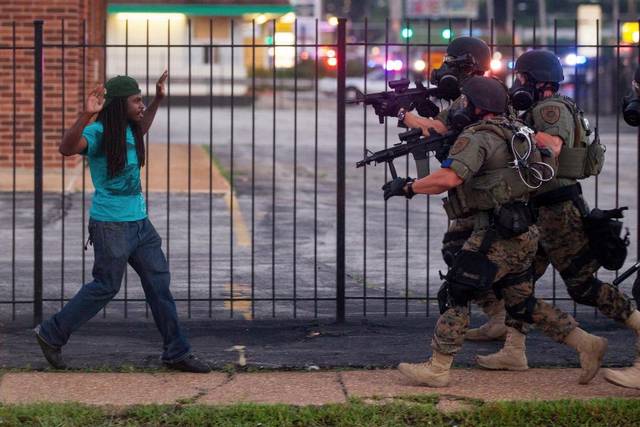The following commentary is with reference to a Kansas City Star article and the accompanying picture set forth below. The picture is no longer part of the on-line story but was part of the print edition:
Would it have been possible to present a more inflammatory, biased, negative depiction of community/police relations than the front page of the Star this past Sunday?
If so, I’d like for the editorial board of the Star to describe what it might look like. As improbable as it might seem, the story related to Ferguson achieved a new low for this newspaper.
A young black man, presumably intended to suggest Derek Hunter, alleged accomplice of Michael Brown, shown with hands raised in the now familiar, “hands up, don’t shoot” pose, appear s to be facing off against menacing law enforcement personnel, clad in military gear, in overwhelming force, brandishing AR15’s. The symbolism could hardly be more divisive and provocative. In this case, poor editorial judgment is matched only by egregiously distorted “reporting”.
A reader, at least, this one, is moved to ask if this was intended to be wildly inflammatory and divisive or is it just the result of an irresponsible and incompetent Star “news” staff? Perhaps it is a combination.
One is hard pressed to not conclude that, either out of ignorance or malevolence, this newspaper chose to use the tragic Ferguson episode, rife with distortion of proven fact and truth, to create or sustain a narrative aimed at provoking divisiveness and distrust, false justification for violence, and for political gain.
I saw no reference in the recap of the events of a year ago to the exhortations of Michael Brown’s stepfather, Louis Head, to “Burn this bitch down”, igniting the prolonged violence which ensued. Your newspaper’s depiction could be plausibly accused of similar motivation.
There are serious issues in America of racial disharmony, of discrimination and distrust among racial and social communities, and certain bad acts, though, rare, by individual police officers which have not been adequately addressed nor have solutions to all the many issues yet been found.
This kind of pandering,however, posing as responsible journalism, does nothing more than arouse the distrust, anger, and divisiveness which makes finding solutions far more difficult.
To present a photograph of the alleged participant in the alleged unlawful activities which led to the tragic death of Michael Brown is disgusting. The pose, in a portrayal of the completely discredited “don’t shoot” gesture is not just unfair, but journalistic malpractice in the extreme. The term”alleged” must be used because no one, alive or deceased, has been prosecuted for perjury for lying to investigators nor for having committed robbery.
Refer red to only as an “irony” in the Star editorial that “hands up, don’t shoot” was a fabrication adopted to create a movement based on a lie beginning to end. Nor was there adequate attention to the fact that a grand jury found no culpability on the part of the police officer, but neither did a subsequent Department of Justice investigation. Apparently those observations would have contributed nothing to the curious intent of the story.
Your editorial quotes, as part of a “crucial undertow emanating from Ferguson”, the question : “Should assaulting an ‘officer of the state’ be a capital offense, rendered without a trial with the officer as judge and executioner? ”
That is an absurdity to invoke an absurd response. Perhaps the Star should follow-up with the question: “Or should society insist that only after the ‘officer of the state’ has been assaulted and perhaps slain, should an attempt to render justice be made?”
Such violent interactions are indeed happening with alarming frequency, especially as of late as tensions are arguably heightened by inflammatory and misleading press coverage.
Nothing in the Star’s narrative of events and their aftermath contributes to anything resembling a balanced portrayal of causes and effects, such as the increasing number of shootings of police officers at the hands of young black males. Or the extent to which grievously unlawful incitement of violence has contributed to some of the very statistics cited in the story.
If the story does anything it only heightens distrust between the races and the black community and law enforcement, and distorts the basis for shifts in public opinion. One may suggest that a story like this with no other honest perspective presented could change public perception. That, of course, may well be the intent of such stories.
Even the anecdote reported about a young black man’s positive interaction with a police officer is distorted, apparently to illustrate the Star’s desired thesis: “Leave the phone on…so we can hear…(the father told the young man pulled over for apparently driving at night without headlights on).
“The officer was very nice, even showed him how to turn the lights on (the rental car he drove). We heard it all and we were proud of our son. That was before Ferguson.”
I have no reason to think that the father should not be proud of his son. But it strikes me as gratuitous that the reporter noted nothing complimentary about the officer’s conduct…only that the incident “occurred before Ferguson”…meaning what? That post-Ferguson the officer might be expected to not act nicely?
It is my belief that, indeed, Ferguson has changed America, not because of the facts of the tragedy, but, in the way media has chosen to depict, distort, and dissemble regarding those facts. If the intent is to cause change in society where it is necessary, then nothing less than full, fair, factual reporting should be the role of journalists. I submit, that is not the case in the manner in which the Star has chosen to treat this most serious matter.
DLH

